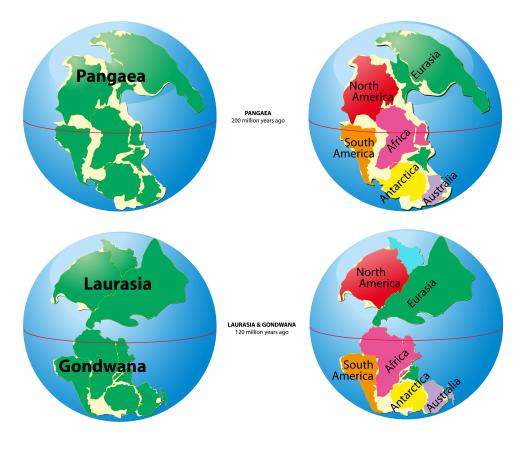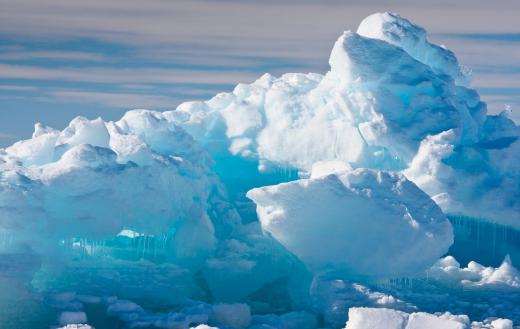How does the Placement of the Continents Affect Global Climate?
 Michael Anissimov
Michael Anissimov
According to the theory of plate tectonics, tectonic plates bearing the world's continents slowly move relative to each other, rearranging them in noticeable ways only over timescales of millions of years. Tectonic plates move about as fast as your fingernails grow. They get pushed around by a phenomenon called seafloor spreading, where the margins of oceanic plates are constantly being subsumed into the mantle, allowing new magma to rush up to fill the cracks forming at the plate's center. Crevices caused by seafloor spreading extend in one continuous line around the ocean floors of the world.
The placement of the continents affects global climate in several ways. The relative arrangement of the continents may regulate the coming and going of major Ice Ages more than solar cycles or any other factor. When there is a continent around the northern or southern polar regions, it is at risk for becoming glaciated and impacting global climate. Especially in the case of Antarctica, which is exclusively polar, a frigid circumpolar current begins circulating the continent and causing feedback cycles of cooling and glaciation. As a result, the Antarctic interior is the largest desert in the world; desert is defined as the absence of moisture. Extremely low temperatures lock all moisture up in ice.

Once, tens of millions of years ago, Antarctica was a lush forest continent. Throughout most of the planet's history, forests extended from pole to pole. Dinosaur fossils have been found within 20 degrees paleolatitude of the South Pole. This is especially remarkable considering that dinosaurs had a slower metabolism than mammals and probably didn't deal with the cold as well. Their sensitivity to global climate is probably what contributed to their downfall. Their inability to deal with global climate changes are what led mammals to survive the mass extinction and for dinosaurs (except the ancestors of birds) to die out.

Another factor that strongly influences global climate is whether the continents are pushed up against each other, as in the supercontinent Pangaea, or largely apart, as is the case today. When the continents are together, it means that much of their land area is very far from the oceans, making it difficult for moisture to reach them, producing deserts. It is thought that the largest desert that ever existed was the center of the continent Pangaea. Today, life is abundant in the interior of most continents, but back then, Pangaea's center would have been devoid of practically all life.
AS FEATURED ON:
AS FEATURED ON:













Discussion Comments
@titans62 - That's a good point, and I think it is up to everyone to read the various reports from both sides of the issue and try to decide what the right answer is. When you get right down to it, the scientists don't even know what the right answer is. I am sort of with you, though. Humans are obviously putting a lot of carbon into the atmosphere that shouldn't be there, but at the same time, the Earth's temperature was increasing before the industrial age.
With this issue of the continents affecting the climate, it might be that the continents are just at locations where the amount of plant life that can grow isn't pulling the same amount of carbon from the atmosphere that it did millions of years ago.
Something else that wasn't really mentioned here was that when things like mountains and other landforms are created by the tectonic plates, that affects climate, too.
With all that's been said, how do the current locations of the tectonic plates reflect on the problem of global warming that we are experiencing right now?
I know a lot of people put the blame solely on humans and the amount of fossil fuel we burn, but couldn't it also be possible that we are just naturally in the middle of a climate shift due to the Earth's own processes?
I'm not saying that none of the climate change can be attributed to humans, but I get the feeling that maybe people are blowing it too far out of proportion, and maybe there is just part of it that we can't change or stop. It is going to happen no matter what we do.
@kentuckycat - I'm not expert on the subject, but I like to study geography, geology, and other similar subjects like that, so I have done some reading on the topic in the past. I think you are on the right path by mentioning how the atmosphere was different several million years ago. Basically, the Earth was in an extreme case of global warming, because there was a ton of carbon in the atmosphere that trapped sunlight and heated up the Earth.
Once plants started growing, dying, and getting buried in the ground (what is now fossil fuels), they started to suck the carbon out of the air. Eventually, enough carbon was gone to produce a similar atmosphere like we have now, so the poles naturally got colder, because of the Earth's tilt.
I think that is the basis of global climate history. Another good question that I don't know right off the top of my head, though, is how the different climates affected the various forms of animal and plant evolution.
So, after reading this, I am pretty sure I understand what a desert is. I think given the mention that Antarctica used to be a lush forested continent, why isn't it still that way? What has caused the climate shift in Antarctica from warm to permanently frozen?
Would it maybe be that when Pangaea was a continent, that Antarctica was further north in latitude and has since migrate to the South Pole, or does it have more to do with the Earth's atmosphere and things like that? I seem to remember hearing different places that the Earth's climate was generally much warmer in the past than it is right now. I don't exactly remember what is supposed to have caused it, though.
Along the same lines, what has caused the various ice ages over the years?
@julies - Once you start studying some of the history behind the global climate facts, a lot of things make more sense than what the average person may realize.
In one of my classes in college, I remember studying some of the global climate charts. As a kid I was fascinated with dinosaurs, so was particularly interested in the Jurassic period.
During the early Jurassic period, Pangea was very hot and dry. What we know of as the Amazon and Congo rainforests today was desert land at that time.
Later on during the Jurassic period, the region of Pangea changed and they began to have snow and ice.
Though there will always be disagreements about this topic, I have found that studying history like this is very interesting and can see why people feel so strongly about it.
As far as the topic of global warming climate changes, I wonder if some areas of the world are more concerned about this than others?
For instance, my son-in-law is from Europe and this is a subject he feels very passionately about. He is usually a pretty quiet guy, but you get him started talking about this topic and he is almost like a different person.
Through it all, you can see how passionately he feels about it. He has also done quite a bit of study and research on this subject.
I don't know if it is from all the research he has done, or if this is something that is discussed more in Europe than in the United States.
This is the first time I had ever thought about Antarctica being a desert. I usually think of a desert as being a hot, dry place - not a very cold, frigid place.
When you think of a desert as being a place where there is no moisture, then it makes sense as far as the ice locking up all the moisture.
Reading about the effects of global climate change is becoming a topic that is discussed more often than it used to be. It is hard to imagine the vast differences in a place like Pangaea compared with what we think of deserts today.
My sister lives in Arizona, and I find that I like that dry, arid climate. If I was going to choose to live in a desert, I would much prefer a place like this than living in Antarctica.
Post your comments